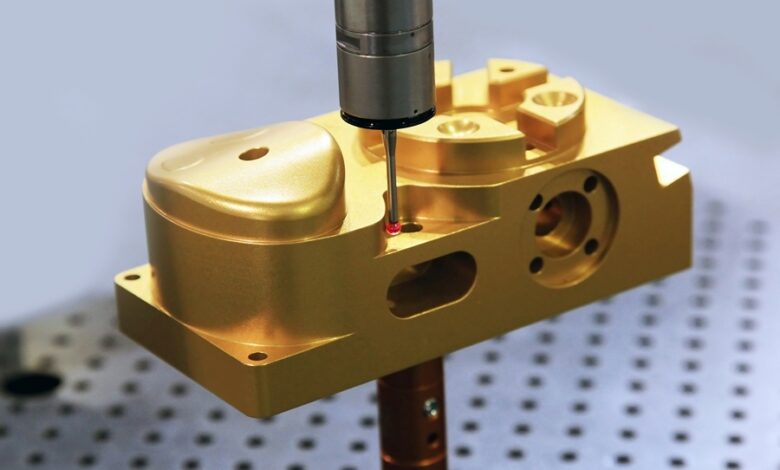How Do You Cut Brass

Brass has a variety of industrial and decorative uses, but how do you shape it for different applications? Curious about the best methods to tackle this metal?
How do you cut brass? Cutting this soft metal takes skill and the right techniques. You can use methods like a laser, waterjet, plasma machine, etc. There is also an option for CNC cutting brass with a router machine. Each method varies in precision and ease, so choose based on your project’s needs.
We’ll discuss various brass cutting methods, helping you determine the right approach for your specific needs. Let’s find out more about the tools and tips for achieving clean, accurate cuts.
What is Brass?
Brass is not a pure metal; it’s a mixture of copper and zinc, which gives it a beautiful golden-yellow appearance. However, it can also look reddish if copper percentage is significantly higher. This reddish variety is known as “red brass.”
Typically, brass contains about 67% copper and 33% zinc, but the copper content can range from 55% to 95%, while zinc can be anywhere from 5% to 45%. Sometimes, the alloy can have a small percentage of other metals, such as lead or iron. Lead can make brass easier to shape and more resistant to rust, while iron can strengthen it.
Brass is known as a substitutional alloy because its atoms of copper and zinc can swap places within its structure. This property allows for flexibility in how brass parts are made and used.
Applications of Brass Parts
Brass is a versatile material used in many areas of everyday life. One of its main advantages is its resistance to corrosion, making it perfect for both decorative and mechanical purposes. Some popular uses of brass parts are:
- Household plumbing and electrical systems. You will find brass parts in valves, plugs, sockets, etc.
- Brass gears and bearings are used in different types of ammunition.
- Fittings and connectors in various mechanical systems. These parts often have low friction, which means they work smoothly together, whether in appliances or tools.
- Household items like fixtures in dishwashers and lamps. These not only look good but also resist bacteria.
- The antibacterial properties of brass make it a popular choice for items like doorknobs and handrails, as it helps reduce the spread of germs.
- Machinery components, including gears and bearings, in various systems.
- Hammers, knives, and different types of sharp tools. The use of brass ensures durability and requires less sharpening over time.
- Different types of musical instruments, such as tubas, trumpets, trombones, and more. Even electric instruments, like guitars, often include brass parts, enhancing their performance.
If you need custom brass parts for your project, you can get high-quality products from any shop that provides CNC cutting service.
How Do You Cut Brass?
Brass is available in various shapes and sizes, making it versatile for projects. And cutting this metal is not a complicated process. Let’s learn details about some popular brass cutting methods.
1. EDM Cutting
A wire EDM machine doesn’t directly contact the brass material when cutting it. Instead, it uses a thin, electrically charged wire to cut through brass with incredible precision. Let’s explore why this process is so effective:
How It Works
In EDM cutting, a wire moves very close to the brass piece, almost like a hair’s width away. This wire disintegrates the brass using electrical sparks that occur at a rapid rate of around 100,000 times in a second. The sparks melt or vaporize tiny bits of metal, creating clean cuts without the need for traditional cutting tools.
Since there’s no physical contact, the brass doesn’t get damaged or hardened, which can happen with other methods.
Precision and Detail
With this cutting method, you can design intricate brass parts. It’s especially important for industries that require detailed brass components, like electronics and automotive parts. The process can produce sharp corners and delicate shapes that are challenging to achieve with regular machining techniques.
Benefits for Brass Cutting
Brass is a versatile metal known for its high tensile strength and malleability. Wire EDM cutting is particularly suited for free-machining brass alloys, allowing for excellent accuracy and a smooth finish.
While brass is softer than some metals, the EDM process can still manage it effectively. The no-contact technique prevents work hardening. However, it’s essential to keep the cutting speed slow to ensure the best results.
2. Laser Cutting
Laser cutting of brass is a modern technique that uses focused laser beams to slice through this shiny, non-ferrous metal. Unlike traditional cutting methods, a laser cutting machine doesn’t apply physical force. It relies on concentrated heat to melt the brass, creating precise cuts. Laser cutter for metal is becoming a favorite among manufacturers and fabricators for its efficiency and accuracy.
How It Works
The process starts with a powerful laser that emits a beam of light. The concentrated light beam heats the brass sheet at a specific point until it melts. When the laser beam cuts the metal, a gas is blown through the cut area to remove the waste parts, leaving behind a clean edge.
Fiber lasers are commonly used for this task because they produce a shorter wavelength of light, which reduces the reflectivity of brass. This helps in achieving a smoother and more effective cut.
Precision and Detail
One of the standout features of laser cutting is its precision. The laser creates narrow slits that are smooth and well-defined. This level of detail is essential for complex designs and patterns.
Since there’s no physical contact with the brass, there’s no risk of deformation or burrs. This means that even large sheets of brass can be cut with the same high level of accuracy as smaller pieces.
Benefits for Brass Cutting
There are several advantages to using laser cutting for brass:
- It allows for quick processing. The laser can move rapidly along the cutting path, saving time during production.
- The cuts are clean, which reduces the need for additional finishing work.
- The method can handle various thicknesses of brass, making it versatile for different projects.
3. Waterjet Cutting
Waterjet cutting is one of the best brass cutting methods. The technique combines high-pressure water with tiny abrasive particles to slice through brass materials and achieve precise cuts. This makes it especially valuable for working with brass, a metal that can be tricky to cut.
How It Works
The process involves pressurizing water to an extreme level and then forcing it through a special nozzle, often made of durable materials like ruby or diamond. When the pressurized water exits the nozzle, it transforms into a high-speed jet, which also carries garnet sand to enhance the cutting power. As the water and sand hit the brass, they work together to erode the material.
Precision and Detail
Waterjet cutting ensures great precision of the cut brass parts. The focused stream allows for intricate designs and detailed shapes to be cut out of brass without damaging the surrounding areas.
This precision minimizes the heat generated during the process, which can lead to warping or other issues. The result is clean edges and a smooth finish, making it ideal for both artistic and industrial applications.
Benefits for Brass Cutting
Choosing waterjet cutting for brass reduces the risk of clogging, a common problem with traditional cutting tools. The minimal heat-affected zone ensures that the brass retains its properties and appearance.
Also, waterjet cutting is versatile. It can handle various thicknesses and complex designs, making it a popular choice in many industries, from jewelry making to aerospace.
4. Plasma Cutting
Plasma cutting is a technique that uses a high-temperature plasma arc to slice through metals. It’s especially effective with brass, a popular metal known for its conductivity and durability. The method is also good for cutting metal sheets of different thicknesses.
How It Works
A plasma cutter generates an electric arc through a gas-filled nozzle. This gas can be nitrogen, oxygen, or argon. When the gas is heated, it transforms into plasma, a state of matter similar to gas but with charged particles. This plasma arc then interacts with the brass, creating a conductive circuit. As the arc moves along the surface, it melts and slices through the brass effortlessly.
Using a handheld plasma torch makes it easier to operate the cutter, allowing for intricate designs and shapes.
Precision and Detail
The plasma arc creates a narrow cut, reducing the amount of material wasted and ensuring precision. Also, the machine can handle intricate patterns, making it ideal for decorative brass pieces or detailed components in machinery. The speed of the process enhances efficiency, allowing craftsmen to produce high-quality products quickly.
Benefits for Brass Cutting
A plasma cutter can cut through a wide range of thicknesses, which is particularly helpful for custom projects. Moreover, the method is fast and efficient, saving both time and labor costs.
Another significant benefit is the reduced risk of warping the material. Since plasma cutting is quick, there’s less heat transfer to the surrounding brass, minimizing distortion. However, it’s essential to be cautious because heating brass too much can release harmful zinc fumes. So, proper ventilation and safety measures are crucial when using this method.
Conclusion
Cutting brass is a crucial step in many projects, from crafting intricate jewelry to creating industrial components. With the right brass cutting methods—like EDM, laser, waterjet, or plasma cutting—you can achieve clean and precise results. Each technique has its unique benefits, so consider what fits your needs best.
If you need precision brass parts, take Zintilon’s expert service for the best results. Our custom solutions of CNC machining, sheet metal fabrication, and other services cater to various industries. Discuss with us your requirements and get a quote!



